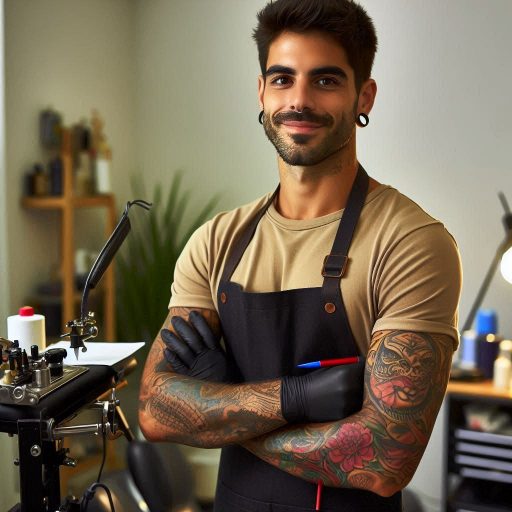Introduction
Event design plays a crucial role in creating memorable experiences for attendees.
Understanding salary insights for event designers in America helps professionals navigate their careers effectively.
Salary trends can inform job seekers about potential earnings and help employers set competitive wages.
The event design industry is dynamic and evolving.
Designers need to stay updated on salary trends to align their skills with market demands.
Knowing the salary landscape aids in negotiating fair compensation and planning for future career growth.
Various factors influence salaries in this field.
Geographic location, experience, and the complexity of events can impact earnings.
By analyzing these elements, designers can make informed decisions about their career paths.
Data from reputable sources provides valuable insights.
Industry reports, salary surveys, and professional organizations offer a comprehensive view of compensation trends.
Online job platforms also present real-time salary data, reflecting market conditions.
This post will explore these salary insights in detail.
We will discuss average salaries for event designers across different regions.
Additionally, we will highlight variations based on experience levels and specific job roles.
Understanding these trends empowers event designers.
It helps them assess their worth in the job market.
By leveraging this information, professionals can enhance their negotiating positions and improve job satisfaction.
In fact, salary insights are essential for event designers.
They provide a roadmap for career advancement and financial planning.
Transform Your Career Today
Unlock a personalized career strategy that drives real results. Get tailored advice and a roadmap designed just for you.
Start NowThis post aims to equip readers with the necessary information to thrive in the event design industry.
Overview of Event Design Industry
The role of event designers in creating memorable experiences
Event designers play a crucial role in creating memorable experiences.
They transform concepts into visually stunning events that resonate with attendees.
Their expertise combines creativity and organizational skills to ensure every detail aligns with the client’s vision.
The demand for event designers in various sectors like corporate events, weddings, and trade shows
The demand for event designers spans various sectors.
Corporate events require engaging experiences to promote brand messages.
Weddings focus on personalization and unique themes, making skilled designers essential.
Trade shows rely on captivating displays to attract visitors, increasing the need for innovative design.
Statistics on the growth of the event design industry in America
Statistics reveal significant growth in the event design industry in America.
The industry is projected to reach over $1 trillion by 2026.
This growth reflects rising investments in live experiences and professional event planning.
The increasing complexity of events demands skilled designers who can navigate logistical challenges while delivering creative solutions.
As the industry expands, event designers find opportunities across diverse sectors.
Companies are investing more in events to enhance customer engagement and brand loyalty.
Additionally, weddings continue to flourish as couples seek distinctive celebrations.
Trade shows also evolve, emphasizing immersive experiences that draw attendees in.
Overall, the event design industry is thriving.
Designers play a pivotal role in crafting unforgettable moments, making them invaluable in various sectors.
The combination of demand, creativity, and industry growth highlights the importance of event designers in today‘s market.
Showcase Your Business Today
Reach thousands of readers actively exploring professional services. Publish your business profile and grow your audience now.
Publish NowEvent designers significantly impact how we experience events.
Their role spans corporate, personal, and public gatherings, emphasizing their versatility.
With the industry’s growth, skilled designers will continue shaping memorable experiences across America.
Read: Online Courses to Improve Your Calligraphy Skills
Average Salary for Event Designers
Present data on the average salary range for event designers in America
Event designers play a crucial role in creating memorable experiences.
Understanding their average salary can help aspiring professionals gauge potential earnings.
Compare salaries based on experience levels, location, and type of events worked on
According to recent data, the average salary for event designers in America ranges from $45,000 to $75,000 annually.
Entry-level positions often start around $40,000, while experienced designers can earn upwards of $90,000.
High demand in urban areas often leads to higher salaries.
Factors that can impact an event designer’s salary, such as education and certifications
Experience greatly influences salary levels.
Entry-level event designers typically earn less than those with several years of experience.
Mid-level designers usually make between $50,000 and $70,000.
Senior event designers, who manage large projects and teams, often command salaries exceeding $80,000.
Additionally, designers specializing in corporate events or high-profile weddings may see increased compensation compared to those in smaller or nonprofit sectors.
Location is another significant factor affecting salaries.
Event designers in major cities like New York, Los Angeles, and Chicago typically earn more than those in rural areas.
Cost of living in these cities is higher, which drives up salaries.
Conversely, designers in smaller towns may earn less, but they may also enjoy a lower cost of living.
Several factors can also impact an event designer’s salary.
Education plays a vital role; those with degrees in design, hospitality, or event management often earn higher salaries.
Certifications, such as those from the International Live Events Association, can further enhance earning potential.
Employers may prioritize candidates with proven skills and recognized credentials.
In summary, event designers can expect a varied salary based on experience, location, and education.
Understanding these factors helps aspiring designers navigate their career paths effectively.
Read: Daily Tasks of a Professional Event Designer
Highest-Paying States for Event Designers
Event designers play a crucial role in creating memorable experiences.
Understanding salary variations is vital for career planning.
Top States for Highest Salaries
The highest-paying states for event designers include California, New York, Texas, Florida, and Illinois.
In California, event designers earn an average salary of $80,000. New York follows closely with an average of $75,000.
Texas offers competitive salaries around $70,000, while Florida and Illinois provide around $65,000.
These figures highlight regional opportunities in the event design industry.
Reasons for Salary Discrepancies
Several factors contribute to salary differences between states.
First, the cost of living significantly impacts salaries.
States like California and New York have higher living expenses, leading to elevated wages.
Second, the concentration of large corporations and events in these states creates more demand for skilled event designers.
Finally, the availability of resources, such as professional networks and training programs, enhances opportunities for event designers.
Job Market Insights
The job market for event designers in high-paying states remains robust.
California boasts numerous film festivals, conferences, and corporate events, creating a steady demand for talent.
New York, known for its vibrant cultural scene, offers ample opportunities in fashion shows, galas, and corporate functions.
Showcase Your Business Today
Reach thousands of readers actively exploring professional services. Publish your business profile and grow your audience now.
Publish NowTexas, with its growing economy, has become a hub for corporate events and trade shows.
Florida attracts many destination events due to its tourism industry, while Illinois serves as a key location for conferences and exhibitions.
In a nutshell, event designers seeking higher salaries should consider relocating to these states.
Understanding the factors driving salary differences can guide informed career decisions.
As the job market continues to expand, opportunities for skilled professionals will grow in these lucrative regions.
Read: How to Turn Your Calligraphy Hobby into a Career

Salary Trends and Projections
Current Salary Trends for Event Designers in America
Event designers in America earn varying salaries based on experience and location.
According to recent data, entry-level designers make around $40,000 annually. Mid-level designers typically earn between $60,000 and $80,000.
Experienced professionals can command salaries over $100,000, especially in major metropolitan areas.
Moreover, freelance event designers often charge hourly rates, impacting overall income.
Salary increases are often linked to successful project completion and client satisfaction.
Future Salary Projections Based on Industry Growth and Demand
The event design industry is poised for growth, driven by increasing demand for experiential events.
As companies invest in unique experiences, event designers will likely see higher salaries.
Projections suggest salaries could rise by 10-15% over the next five years.
Additionally, the rise of virtual and hybrid events will create new opportunities, expanding job prospects.
Designers with specialized skills in digital events may command premium rates.
The growing industry signals a positive trend for salaries.
Economic Factors Influencing Event Designers’ Salaries
Economic conditions play a critical role in determining salaries for event designers.
During economic downturns, companies often cut back on event budgets, affecting designer incomes.
Conversely, a booming economy can lead to increased budgets and higher pay for designers.
Inflation also impacts purchasing power, making salary adjustments necessary.
Additionally, demand for skilled professionals will influence compensation, especially in competitive markets.
Therefore, event designers should remain adaptable to economic shifts that may impact their earnings.
Basically, the salary landscape for event designers in America is evolving.
Current trends show promising growth, with projections indicating a positive trajectory.
Economic factors will continue to shape salaries, requiring designers to stay informed and adaptable.
Read: Art and Design Trends to Watch This Year
Gender Pay Gap in Event Design Industry
The issue of gender pay gap among event designers in America
The gender pay gap remains a significant issue in the event design industry in America.
Despite progress in many sectors, female event designers often earn less than their male counterparts.
This disparity affects not only individual professionals but also the industry as a whole.
Statistics on the salary differences between male and female event designers
Recent statistics reveal notable salary differences between male and female event designers.
According to industry reports, female event designers earn approximately 80% of what their male colleagues make.
For example, while men may earn around $70,000 annually, women often make closer to $56,000 for similar roles.
This gap reflects broader societal issues and highlights the need for change.
Efforts and initiatives to close the gender pay gap in the industry
Various efforts and initiatives aim to address and close the gender pay gap in event design.
Many organizations are implementing transparency policies regarding salaries, encouraging open discussions about pay. Industry leaders advocate for equitable pay structures based on experience and qualifications rather than gender.
Additionally, mentorship programs are emerging to support female designers in advancing their careers.
Professional associations are also taking steps to raise awareness about the gender pay gap.
They provide resources and tools for women in event design to negotiate salaries effectively.
Workshops and seminars focus on empowering women to advocate for their worth in the workplace.
Showcase Your Business Today
Reach thousands of readers actively exploring professional services. Publish your business profile and grow your audience now.
Publish NowMoreover, companies that prioritize diversity and inclusion often see improved financial performance.
By recognizing the value of equitable pay, the industry can foster a more inclusive environment that benefits everyone.
Closing the gender pay gap in event design is not just a moral imperative; it is essential for the industry‘s growth and success.
Basically, addressing the gender pay gap requires collective effort and commitment from all stakeholders.
By implementing effective initiatives and policies, the event design industry can move toward a more equitable future.
Gain More Insights: Top Skills for Aspiring Motion Graphics Designers
Benefits and Perks for Event Designers
The non-monetary benefits and perks that event designers receive
Event designers often enjoy a range of non-monetary benefits that enhance their job satisfaction.
These perks can significantly impact their overall well-being and career growth.
Common benefits like health insurance paid time off, and professional development opportunities
Health insurance is a common benefit for event designers.
Many employers provide comprehensive plans that cover medical, dental, and vision care.
This coverage helps designers manage healthcare costs, ensuring they can focus on their creative work.
Paid time off (PTO) is another essential perk.
Employers typically offer vacation days, sick leave, and personal days.
This flexibility allows event designers to recharge and maintain a healthy work-life balance.
Taking time off enhances their creativity and prevents burnout.
Unique perks offered by some employers in the event design industry
Professional development opportunities are crucial in the dynamic field of event design.
Employers often support attendance at workshops, conferences, and courses.
These experiences help designers refine their skills and stay updated on industry trends.
Continuous learning leads to career advancement and increased job satisfaction.
In addition to standard benefits, some employers offer unique perks.
For instance, flexible work arrangements enable designers to work remotely or adjust hours.
This flexibility accommodates personal needs and enhances productivity.
Another enticing perk is event attendance.
Many companies encourage designers to attend industry events, allowing them to network and gain insights.
Free or discounted tickets to events provide invaluable experiences that enrich their portfolios.
Additionally, creative workplaces often provide inspiring environments.
Some companies design their offices to stimulate creativity, featuring collaborative spaces and artistic decor.
This unique atmosphere fosters innovation and enhances the overall work experience.
Therefore, the benefits and perks for event designers extend beyond salary.
Health insurance, PTO, and professional development opportunities are vital.
Unique perks, such as flexible work arrangements and event attendance, further enhance their job satisfaction.
By valuing these aspects, employers attract and retain top talent in the competitive event design industry.
Tips for Negotiating Salary as an Event Designer
Practical advice on how event designers can negotiate their salaries
Negotiating salary can be challenging for event designers.
However, with the right strategies, you can secure a fair compensation.
Here are some practical tips to help you navigate this process effectively.
First, research industry standards.
Understand the average salary range for event designers in your area.
Use resources like salary surveys or job boards to gather data.
This information equips you with a solid foundation for your negotiation.
Strategies for showcasing skills, experience, and value during salary negotiations
Next, showcase your skills and experience.
Showcase Your Business Today
Reach thousands of readers actively exploring professional services. Publish your business profile and grow your audience now.
Publish NowPrepare a portfolio highlighting your best work.
Include successful projects, client testimonials, and quantifiable results.
This evidence demonstrates your value and justifies your salary expectations.
Insights on when and how to ask for a raise in the event design industry
When discussing salary, frame your request positively.
Start by expressing enthusiasm for your role and the company.
Use phrases like, “I am excited about contributing to our upcoming projects.”
This sets a collaborative tone and encourages open dialogue.
Be specific about your accomplishments.
Discuss how your skills directly impact the company’s success.
For instance, mention how your designs increased attendance at previous events.
This establishes a clear connection between your work and the organization‘s goals.
Timing is also crucial when asking for a raise.
Consider your performance review period as an optimal moment.
Alternatively, request a meeting after successfully completing a significant project.
This timing reinforces your case for a salary increase.
Lastly, practice your negotiation skills.
Conduct mock negotiations with a friend or mentor.
This practice helps you refine your delivery and boosts your confidence.
Remember, negotiation is a conversation, not a confrontation.
Effective salary negotiation involves research, showcasing your value, and timing your requests strategically.
By employing these tips, you can advocate for your worth in the event design industry.
Conclusion
Event designers in America can expect varying salaries based on factors like location, experience, and industry demand.
The average salary range falls between $40,000 to $80,000 per year, with opportunities for growth and advancement.
It is crucial for event designers to stay informed about industry trends and salary benchmarks to negotiate effectively and make informed career decisions.
By researching salary insights and understanding the market, professionals can position themselves competitively in the industry.
For further insights, individuals can explore resources such as industry reports, salary surveys, and networking opportunities within the event design community.
Continuing education, certification programs, and staying updated on market demands can also contribute to career advancement and salary growth.
Event designers in America have the potential to thrive in a dynamic and creative industry, with opportunities for earning competitive salaries based on skills, expertise, and market demand.
By staying informed and proactive, professionals can achieve their career goals and succeed in the field of event design.
[E-Books for Sale]
The Big Book of 500 High-Paying Jobs in America: Unlock Your Earning Potential
$19.99 • 500 High-Paying Jobs • 330 pages
Explore 500 high-paying jobs in America and learn how to boost your career, earn more, and achieve success!
See All 500 High-Paying Jobs of this E-Book
1001 Professions Without a Degree: High-Paying American Jobs You Can Start Now
$19.99 • 1001 Professions Without a Degree • 174 pages
Discover 1001 high-paying jobs without a degree! Unlock career tips, skills, and success strategies for just $19.99!




